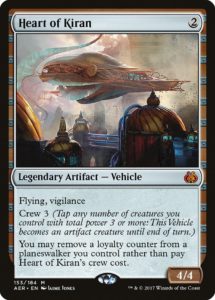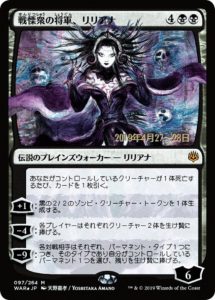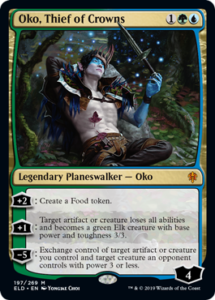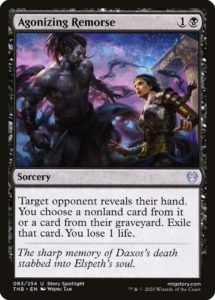Yesterday was Magic’s annual sate of State of Design. It hit strangely. Normally, these articles address large, overarching issues and triumphs of the past year. Each year tends to relate to the next, meaning you can see how Magic reacted to the previous year.
For example, setting expectations was a major issue in 2018, with Ixalan, Rivals of Ixalan, Core Set 2019, and Battlebond all having issues communicating what they were about and who they were for. 2019 saw much improvement in clearly giving players what they wanted (though Modern Horizons’ marketing did confuse people about it being a Modern-focused set rather than Time Spiral 2). 2020 touched upon this thread with Ikoria: Lair of Behemoths not quite setting proper expectations. But this clear throughline of design challenge and successes is far more muddled in 2020’s State of Design.
To demonstrate what’s different about this year’s State of Design, let’s compare the major topics of the past three years.
2018’s Big Picture Successes
Internal restructuring. Where once there was Design and Development, there is now Vision Design, Set Design, and Play Design. This increased specialization led to much improved workflows. (This restructuring was likely part of the process of or the precursor to tabletop design being restructured into Studio X).
The Blockless Paradigm. Magic blocks always struggled with third sets, but the Two Block Paradigm made it clear that second sets were also problematic. By cutting the fat and focusing on the biggest, boldest, and almost certainly best-selling first sets, Magic set itself up for success. The increased work required to generate three unrelated worlds a year likely necessitated the internal restructuring.
Innovation. Dominaria and Ixalan tried out a bunch of new things, from new takes on double-faced cards and sagas to rehabilitating Kamigawa’s legendary subtheme while revisiting Magic’s hardest-to-visit home plane.
2018’s Big Picture Issues
Ixalan. Ixalan hit too low on complexity and skipped out on inter-tribal glue—a lesson Magic already learned from Onslaught and Lorwyn—making it a tumultuous set.
Communication. As discussed, Magic had problems with sets properly communicating what they were about and who they were for.
2019’s Big Picture Successes
Appropriate Complexity. After years of overshooting complexity and then painfully undershooting it with Ixalan, Magic finally seemed to have a solid handle on the scourge of game designers everywhere.
Hitting Player Desires. As previously discussed, this was a big issue in 2018 and demonstrated progress.
Tool Innovation. 2018 saw Magic restructure itself internally to better develop products, while 2019 saw Magic embrace new technology like collation or familiar tricks like card frames to design better, clearer products.
Event Set. War of the Spark pioneered a new type of set, one created for Magic’s story rather than top-down (by resonant real-world inspiration) or bottom-up (from mechanics first). This was a major triumph of War of the Spark, despite the lack of a story build-up for the preceding year. Furthermore, this success was curiously followed up by an enormous palate cleanser, where Magic curtailed most of its narrative content (after severe quality issues) and saw a year of narratively unrelated sets.
2019’s Big Picture Issues
Limited Synergy Between Sets. Traditionally, consecutive planes never share keywords. When every set is its own self-contained world, every mechanic only shows up in one set. This makes entire decks appear with one set and stay together until rotation (or bans). This issue shows up again in 2020’s State of Design.
Release Schedules. Magic had a large schedule gap between Guilds of Ravnica and Ravnica Allegiance but a nonstop spoiler season between War of the Spark and Throne of Eldraine. Rosewater doesn’t touch upon this major problem in 2020, the year when the summer was just as packed but the winter, spring, and summer all had Secret Lairs to fill in the gaps.
One Missing Plotline. Three major Planeswalkers died in War of the Spark, but Dack Fayden’s death was never shown on the cards. This wasn’t an inconsistency, just a fault of the order in which sets and stories have to be created.
I’m just skimming the surface of the past two years’ States of Design, but it’s important to create some context when looking at this year’s. Something is off.
State of Design 2020
This is an interesting way to start the piece. On the one hand, sure this is a likely a reflection of Magic’s overall health and a worthy pat on the back for everyone at Wizards—but there’s not much to glean from this broad data point. It’s a general metric of success that doesn’t tell us where credit is due or what lessons design takes from it. Heck, this could only be an indication of past success rather than present success—Battle for Zendikar long held the record for best-selling set ever but suffered from some of the biggest design issues of the past decade. Sales dropping off after it suggest that it achieving that record might not have been heavily due to its own merits.
To be clear, it’s a good thing that Magic is making money. Sure, there are discussions to be had about some of the products making that money, but Magic has to be successful business in order to be in business.
Solid point, absolutely true. In fact, we covered this last week. After restructuring internally and embracing new tools, Magic used these assets to great effect. This is the kind of point I expect from State of Design.
Perhaps this is a communication issue, but I thought these were the primary purview of Product Architecture, not Vision Design. It’s good that Magic is finding new ways to expand its player base, satisfy its existing bases, and better monetize itself (which feeds back into the year being financial successful). But I’m again not seeing how this is a Vision Design success or what they’ve learned about designing new sets. Perhaps needing a special frame treatment every set gives design a better focus for crafting worlds, but I don’t know. Again, we’re being told something was well received but not what was learned.
This is a Play Design issue. It’d seem an odd inclusion as a major Vision Design issue for the year, but ten cards banned in Standard and another ten nerfed can’t be ignored. Later on in the article, MaRo shares the insight that Ikoria having both Mutate and Companion, two complicated and unprecedented mechanics, gave Play Design an unduly difficult task. I look forward to hearing more about the thought process behind Companion’s design (particularly when Magic had already cut similar, weaker mechanics from Tempest and Avacyn Restored), but I’m concerned that we’re most of the way through the major points and only one of them is a Vision Design responsibility.
Standard’s power level was intentionally increased over the past year. This led to unprecedented Standard volatility and every expansion drastically changing every nonrotating format (except for Core Set 2021). Some of this seems intentional, especially if tabletop Magic is increasingly relying on Commander, Pioneer, and Modern players rather than a robust offline Standard playerbase. But the solution sounds like Magic dedicating more Play Design resources to nonrotating formats. It’s not clear what Mark Rosewater has learned, how this is a Vision Design problem, or what solutions they have.
Two of the biggest issues with 2020 being Play Design issues isn’t surprising—this was a rough year for balance—but this is a Vision Design article. The State of Design focusing so much on issues that Vision Design isn’t (or mostly isn’t) responsible for and can’t address feels like their lessons aren’t being shared with the audience, or worse, aren’t being learned.
This is a returning theme from 2019 and the kind of thing I expected to see more of in this article. The prognosis also isn’t stellar—Magic’s second year of the blockless paradigm has many of the same challenges as the first. It’s unclear how they’re going to regain some of the inter-set synergies that were easy to come by when sets had overlapping mechanics and shared a world. Perhaps Magic might return to having a two set block every other year (just as Core Sets returned to solve the issues their absence caused), or perhaps Magic will experiment with overlapping mechanics on sets in Standard (such as putting Adventures in Zendikar or if Eldraine had sagas and sagas-matter cards to go with Theros).
War of the Spark was criticized for not including a substantial (but not plot-essential) element in a set overstuffed with story. The problem stemmed from design decisions being locked in before a book could be written, so creative freedom meant minor and moderate story arcs couldn’t make it onto the cards. Ikoria took this quality control issue and ran with it, having the cards and book actively contradict each other (something that last happened, perhaps, with Quest for Karn and Scars of Mirrodin?). War of the Spark’s two books also suffered from major quality control issues, resulting in Theros Beyond Death’s story never coming to market.
These are major issues. Magic’s story has been my biggest disappointment with the game for the past two years (I’m a Gatewatch fan). Not having regular stories to read and share with friends has led to me spending that time on non-Magic pursuits. But you know what? Just as Booster Fun seems to be the domain of Product Architecture and game balance that of Play Design, these are issues within Creative’s world. Yes, problems there are problems for all of Magic; but once again, I’m left with the feeling that MaRo is pointing out problems the audience is fully aware of, that he likely doesn’t have the power to change, and that he’s focusing on to the exclusion of successes and lessons that are under Vision Decision’s umbrella.
This year’s State of Design felt akin to Theros Beyond Death’s Story Spotlights. Where once were clear windows into a world, now there are vague and broad snippets. The major takeaways seem to be that people are happily buying Magic, Play Design and Creative have major challenges ahead, and Vision Design is still trying to solve the problems of the Blockless Paradigm. There’s a glaring hole on the subject of release schedules, a major problem in 2016 and 2019 that seems to have been outdone by 2020.
Perhaps MaRo focusing so much of the article on other parts of the company is evidence of Studio X being more than R&D was, or perhaps it’s a symptom of Magic now having multiple studios with competing interests. I don’t know, and I feel I’ve learned less from this State of Design than any other.
—Zachary Barash is a New York City-based game designer and the commissioner of Team Draft League. He designs for Kingdom Death: Monster, has a Game Design MFA from the NYU Game Center, and does freelance gatame design. When the stars align, he streams Magic (but the stars align way less often than he’d like).











